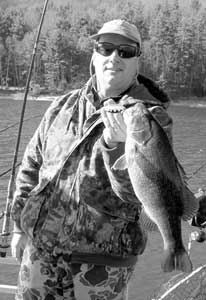
Winter is a prime time for smallmouth bass fishing at the mountains. Smallmouth fish are just as active in the winter as they are during the fall and spring. If it’s bitterly cold, you might as well stay home, but when the sun comes out and warms the water and the spirit, fishing, especially smallmouth bass fishing, can be as good as it gets. Fair-weather respites often last two or three days, sometimes a week or more. Weather is one of the major benefits for anglers living in the South.
Biologists and avid anglers concur the best smallmouth lakes are Fontana Reservoir (Graham and Swain counties), Santeetlah (Graham County), Glenville (also known as Thorpe in Jackson County) and Hiwassee (Cherokee County). And these lakes offer prime winter fishing.
Jim Mathis of Almond Boat and RV Park at Fontana Reservoir said one of the most-effective methods of catching smallmouth bass during winter is fishing with crankbaits, particularly a 1/4-ounce Pop-R. Favored winter colors are black and silver and blue and bone.
“We get some surface activity in the winter,” he said, especially during warm spells when bait minnows school.
The best lure for winter smallmouth fishing is one that’s difficult to find, Mathis said. It’s the Herder’s Killer Jig, which has a red head, chartreuse chenille body and a white marabou tail.
“If you can find one,” he said, “you’ll absolutely catch a load of smallmouth.”
Fontana’s smallmouth population has improved considerably the past few years. On average, smallmouth run 14 to 15 inches and average between 2 and 3 pounds.
Shiners also are an effective bait for winter smallmouth fishing.
“I’ve caught more smallmouth on minnows than I have with anything else,” said former fishing guide Danny Brower of Sylva.
Smallmouth don’t go very deep, Brower said.
“Usually they’re 30 to 40 feet, mainly near creek mouths and at the sides of channels where the water is warmer,” he said. “Early morning and late afternoon are usually the best times to fish these areas.”
Brower said he’ll tie on a slip-bobber and let a minnow dangle about a foot above the bottom of the area he’s fishing.
“That lets the minnow swim right over the bottom where a smallmouth can see it,” he said.
At Santeetlah Lake, marina-owner Randall Veal said the lake offers some excellent winter bass fishing. The lake once was best known for its largemouth bass, Veal said, but the smallmouth have taken over. Veal said smallmouth go to deep water during January and February.
Crankbaits and live minnows are the preferred baits. The most popular lures are Yo-Zuri and Shad Rap in perch and shad colors.
The lake’s only marina is closed during winter, but three public access areas are open year-round and include Avery Creek, 11 miles west of Robbinsville; Massey Branch, near the Cheoah Ranger Station, 5 miles west of Robbinsville on State Road 1127; and Cheoah at Cheoah Campground on N.C. 28.
Hiwassee Reservoir in Cherokee County holds the record for the state’s largest smallmouth — 10 pounds, 2 ounces. That record was set in 1951 and is unlikely to be beaten since smallmouth rarely get that large this far south. The lake has a fairly strong population of smallmouth bass.
Local fishers have fair to good success in the winter fishing feeder streams with minnows and spinnerbaits. Crankbaits and grubs also are used with fair success.
Smallmouth are more dispersed in the winter when the lake’s level drops. Without their preferred shoreline cover, the fish seek out rocky areas in deep water.
Lake Glenville, or Thorpe Lake, in western Jackson County often is overlooked as a smallmouth bass fishing destination.
“It’s not the kind of lake to limit out every day,” Jones said, “but you can catch some good quality fish.”
Jones’ preferred method of fishing is trolling with his own Marty Jones Special Spoon or a No. 5 Rapala. When smallmouth are breaking, he switches to a Pop-R.
Fishing may be a bit slower in the winter, but with a little patience and planning, you can have a year-round fishing experience.
Watch for a warm spell, get your tackle out of storage, hitch up the boat, and head for some good fishing. The fish will be waiting, and, best of all, you’ll likely have the prime spots all to yourself.



